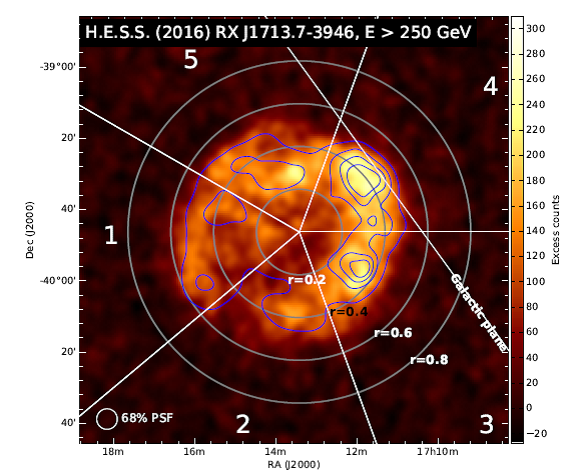Ion Acceleration in Supernova Remnants: an Open Problem
Shocks of supernova remnants (SNRs) are believed to be the major agent for acceleration of galactic cosmic rays. However, direct evidence for such a scenario is only available in the GeV range, where a gamma-ray spectral bump associated with decay of neutron pions produced by inelastic collisions of high-energy ions with the background nuclei has been detected from several SNRs. Since the detection of TeV emission from SNRs, whether the gamma-rays are mostly produced via leptonic or hadronic processes has been a matter of debate, which has significant implications on the origin of TeV cosmic rays.
In a recent paper by TANG and LIU published in The Astrophysical Journal, it is found that, in the context of diffusive shock particle acceleration, the leptonic model for the gamma-ray emission has difficulties in reproducing the multi-wavelength observations of the brightest TeV SNR RX J1713.7-3946, the origin of gamma-ray emission from RX J1713.7-3946 is still an open problem. Moreover, as shown in Fig. 1, the gamma-ray image of SNR RX J1713.7-3946, the radial brightness profiles are different in different directions [1]. In particular, the authors applied a one dimensional diffusive shock particle acceleration model to X-ray and gamma-ray observations of SNR RX J1713.7-3946 and found that although the leptonic model for the gamma-ray emission may reproduce the multi-wavelength spectrum, it has difficulties in reproducing the X-ray and gamma-ray brightness profiles simultaneously.

Fig. 1 Gamma-ray image of Supernova Remnant RX J1713.7-3946 (Image by H.E.S.S. Collaboration)
Fig. 2 shows that the leptonic model can reproduce the X-ray brightness profiles, but fails to account for a more extended structure in the shock upstream revealed by the gamma-ray image. This result either implies limitations of the diffusive shock particle acceleration model, or suggests efficient ion acceleration in this source as has been explored by ZHANG and CHEN (2016). Expansion of this study to more SNRs will help to address the origin of TeV cosmic rays.


Fig. 2 X-ray and Gamma-ray radial brightness profiles (Image by LIU Siming)